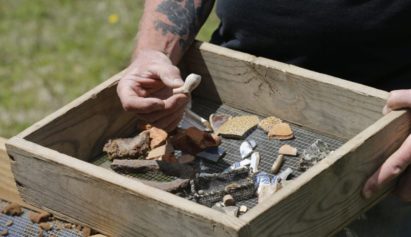In 2016, construction on the Smithsonian’s National Museum of African American History and Culture will hopefully be completed after being pushed back another year from its original 2015 completion date.
While the public will have to wait to see the entire exhibit come to life, curators have already planned to give everyone a taste of what the massive project will one day bring.
Curators Jackie Serwer and Rhea L. Combs have created a special exhibit to highlight some of the pieces that will one day call the NMAAHC home.
“Through the African American Lens: Selections from the Permanent Collection” will open Friday and provide the first sneak peek at what the NMAAHC will have to offer.
It’s been no easy task considering the sheer size of the planned museum and the vast collection of items that it will house.
“It’s been a real challenge for us to take the museum’s roughly 400,000 square feet and reduce it down to 2,700 square feet,” Combs told The Washington Post.
The exhibit will, on a smaller scale, tackle all aspects of African-American history from well-known civil rights leaders and the trials of slavery to the unsung heroes of the military who broke barriers for Black men and women who wanted to serve.
“We wanted to show the sweep and scope of African-American history, including families who were never enslaved,” Combs explained.
The history section of the exhibit will have items like shackles and sugarcane knives on display in addition to a shawl worn by Harriet Tubman. It will also help detail the story of the Perkins-Dennis family in Pennsylvania.
“Patriarch Prince Perkins likely fought in the Revolutionary War and used the money he earned to buy a farm, which his descendants still own,” The Washington Post explains.

French World War I Victory medal received by Lawrence McVey, after 1918. From the Collection of the Smithsonian National Museum of African American History and Culture
Another section will highlight Black war heroes and includes a rare photo of Massachusetts’ 55th Volunteer Regiment, which was “an infantry unit that fought to free enslaved people in the South.”
Unlike many exhibits that honor Black people and their history, however, the curators wanted to make sure that the displays were not just about the days of slavery.
The Black culture section will have Althea Gibson’s tennis racket on display — the same one she used to win the women’s singles title at Wimbledon in 1957.
Black athletes are a key part of the culture exhibit as it not only focuses on their accomplishments but shows the extreme hurdles they were forced to jump over to achieve success.
The largest piece at the exhibit will be a musical piece from the iconic James Brown.
“Many people don’t realize that organ was the first instrument he played,” Combs said of the giant electric organ that will be on display. “He liked to start out his concerts on the organ, and people didn’t realize at first it was him playing.”
All of the items will be on display in the same space for the exhibit, but when they are moved into the museum, the cultural and historical pieces will be separated on different floors.



